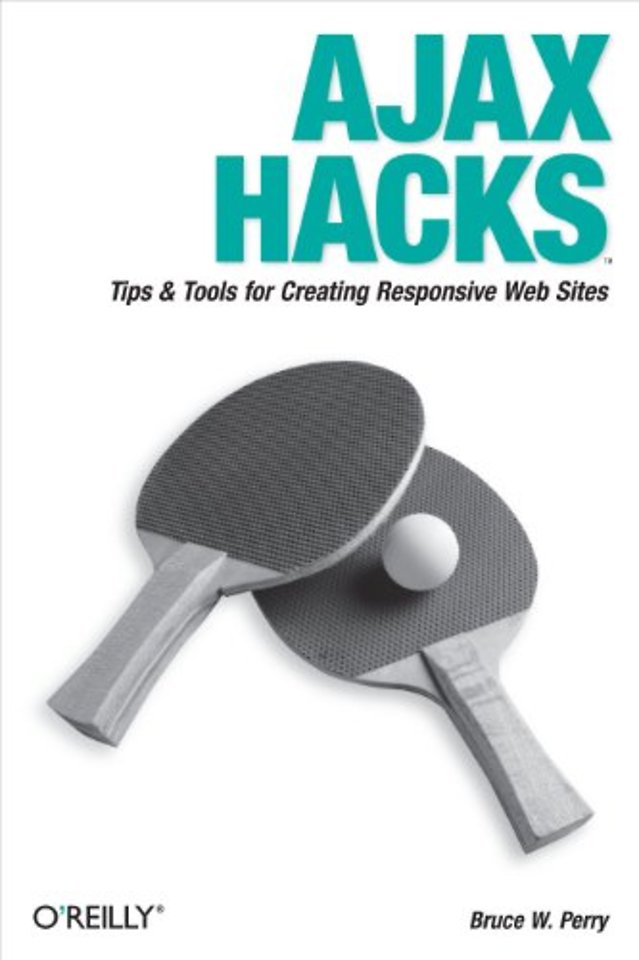Samenvatting
Ajax, the popular term for Asynchronous JavaScript and XML, is one of the most important combinations of technologies for web developers to know these days. With its rich grouping of technologies, Ajax developers can create interactive web applications with XML-based web services, using JavaScript in the browser to process the web server response.
Taking complete advantage of Ajax, however, requires something more than your typical "how-to" book. What it calls for is Ajax Hacks from O'Reilly. This valuable guide provides direct, hands-on solutions that take the mystery out of Ajax's many capabilities. Each hack represents a clever way to accomplish a specific task, saving you countless hours of searching for the right answer.
A smart collection of 80 insider tips and tricks, Ajax Hacks covers all of the technology's finer points. Want to build next-generation web applications today This book can show you how. Among the multitude of topics addressed, it shows you techniques for:
Using Ajax with Google Maps and Yahoo MapsDisplaying Weather.com dataScraping stock quotesFetching postal codesBuilding web forms with auto-complete functionality
Ajax Hacks also features a number of advanced hacks for accelerated web developers. Discover how to create huge, maintainable bookmarklets, how to use client-side storage for Ajax applications, and how to call a built-in Java object from JavaScript using Ajax. The book even addresses best practices for testing Ajax applications and improving maintenance, performance, and reliability for JavaScript code.
The latest in O"Reilly's celebrated Hacks series, Ajax Hacks smartly complements other O'Reilly titles such as Head Rush Ajax and JavaScript: The Definitive Guide.
Specificaties
Lezersrecensies
Inhoudsopgave
Credits;
About the Author;
Contributors;
Acknowledgments;
Preface;
Building Single-Page Applications;
Explaining Ajax;
How to Use This Book;
How This Book Is Organized;
Conventions Used in This Book;
Using Code Examples;
Safari Enabled;
How to Contact Us;
Got a Hack?;
Chapter 1: Ajax Basics;
It’s Not a Floor Wax;
Handle with Care;
XMLHttpRequest;
1 Detect Browser Compatibility with the Request Object;
2 Use the Request Object to POST Data to the Server;
3 Use Your Own Library for XMLHttpRequest;
4 Receive Data as XML;
5 Get Plain Old Strings;
6 Receive Data as a Number;
7 Receive Data in JSON Format;
8 Handle Request Object Errors;
9 Dig into the HTTP Response;
10 Generate a Styled Message with a CSS File;
11 Generate a Styled User Message on the Fly;
Chapter 2: Web Forms;
12 Submit Text Field or textarea Values to the Server Without a Browser Refresh;
13 Display Text Field or textarea Values Using Server Data;
14 Submit Selection-List Values to the Server Without a Round Trip;
15 Dynamically Generate a New Selection List Using Server Data;
16 Extend an Existing Selection List;
17 Submit Checkbox Values to the Server Without a Round Trip;
18 Dynamically Generate a New Checkbox Group with Server Data;
19 Populate an Existing Checkbox Group from the Server;
20 Change Unordered Lists Using an HTTP Response;
21 Submit Hidden Tag Values to a Server Component;
Chapter 3: Validation;
22 Validate a Text Field or textarea for Blank Fields;
23 Validate Email Syntax;
24 Validate Unique Usernames;
25 Validate Credit Card Numbers;
26 Validate Credit Card Security Codes;
27 Validate a Postal Code;
Chapter 4: Power Hacks for Web Developers;
28 Get Access to the Google Maps API;
29 Use the Google Maps API Request Object;
30 Use Ajax with a Google Maps and Yahoo! Maps Mash-up;
31 Display a Weather.com XML Data Feed;
32 Use Ajax with a Yahoo! Maps and GeoURL Mash-up;
33 Debug Ajax-Generated Tags in Firefox;
34 Fetch a Postal Code;
35 Create Large, Maintainable Bookmarklets;
36 Use Permanent Client-Side Storage for Ajax Applications;
37 Control Browser History with iframes;
38 Send Cookie Values to a Server Program;
39 Use XMLHttpRequest to Scrape an Energy Price from a Web Page;
40 Send an Email with XMLHttpRequest;
41 Find the Browser’s Locale Information;
42 Create an RSS Feed Reader;
Chapter 5: Direct Web Remoting (DWR)for Java Jocks;
43 Integrate DWR into Your Java Web Application;
44 Use DWR to Populate a Selection List from a Java Array;
45 Use DWR to Create a Selection List from a Java Map;
46 Display the Keys/Values from a Java HashMap on a Web Page;
47 Use DWR to Populate an Ordered List from a Java Array;
48 Access a Custom Java Object with JavaScript;
49 Call a Built-in Java Object from JavaScript Using DWR;
Chapter 6: Hack Ajax with the Prototype and Rico Libraries;
50 Use Prototype’s Ajax Tools with Your Application;
51 Update an HTML Element’s Content from the Server;
52 Create Observers for Web Page Fields;
53 Use Rico to Update Several Elements with One Ajax Response;
54 Create a Drag-and-Drop Bookstore;
Chapter 7: Work with Ajax and Ruby on Rails;
Sensible MVC;
55 Install Ruby on Rails;
56 Monitor Remote Calls with Rails;
57 Make Your JavaScript Available to Rails Applications;
58 Dynamically Generate a Selection List in a Rails Template;
59 Find Out Whether Ajax Is Calling in the Request;
60 Dynamically Generate a Selection List Using Database Data;
61 Periodically Make a Remote Call;
62 Dynamically View Request Information for XMLHttpRequest;
Chapter 8: Savor the script.aculo.us JavaScript Library;
63 Integrate script.aculo.us Visual Effects with an Ajax Application;
64 Create a Login Box That Shrugs Off Invalid Logins;
65 Create an Auto-Complete Field with script.aculo.us;
66 Create an In-Place Editor Field;
67 Create a Web Form That Disappears When Submitted;
Chapter 9: Options and Efficiencies;
68 Fix the Browser Back Button in Ajax Applications;
69 Handle Bookmarks and Back Buttons with RSH;
70 Set a Time Limit for the HTTP Request;
71 Improve Maintainability, Performance, and Reliability for Large JavaScript Applications;
72 Obfuscate JavaScript and Ajax Code;
73 Use a Dynamic script Tag to Make Web Services Requests;
74 Configure Apache to Deal with Cross-Domain Issues;
75 Run a Search Engine Inside Your Browser;
76 Use Declarative Markup Instead of Script via XForms;
77 Build a Client-Side Cache;
78 Create an Auto-Complete Field;
79 Dynamically Display More Information About a Topic;
80 Use Strings and Arrays to Dynamically Generate HTML;
Rubrieken
- advisering
- algemeen management
- coaching en trainen
- communicatie en media
- economie
- financieel management
- inkoop en logistiek
- internet en social media
- it-management / ict
- juridisch
- leiderschap
- marketing
- mens en maatschappij
- non-profit
- ondernemen
- organisatiekunde
- personal finance
- personeelsmanagement
- persoonlijke effectiviteit
- projectmanagement
- psychologie
- reclame en verkoop
- strategisch management
- verandermanagement
- werk en loopbaan

